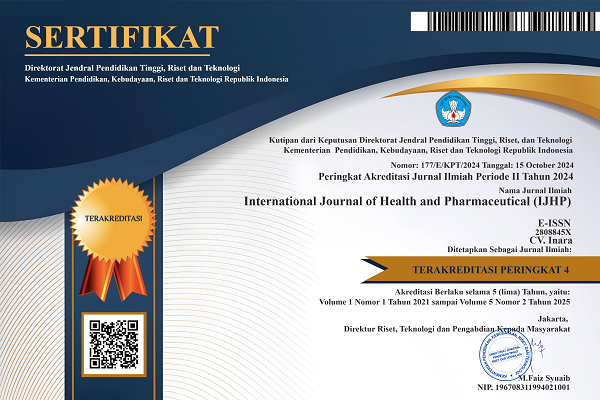Analysis Of Water Quality Of The Babura River And Its Users By The Community With Skin Health Complaints In Medan
DOI:
https://doi.org/10.51601/ijhp.v2i4.83Abstract
The water quality of the Babura River is increasingly worrying because of the pollution of domestic waste that occurs. The water condition of the Babura River is physically cloudy in color, looks oily and the river contains human feces. The use of polluted Babura River water can cause health complaints, including skin health problems. The purpose of this study was to determine the water quality of the Babura River, as well as the relationship between water use and skin health complaints in the community in the watershed. This research is an analytic survey using a Cross-Sectional design. There was 592 population in this study, living in the Babura River watershed in Petisah Hulu Village. The number of samples in this study was 86 households determined by the Slovin Formula where sampling was carried out by accidental sampling. Data analysis used Chi-square Test (α=95%). Sampling points were carried out at 3 locations namely Station 1, Station 2, and Station 3. The results showed that water quality had decreased in quality where the Dissolved Oxygen (DO), fecal coli, and total coliform parameters did not meet the river water quality standards according to Government Regulation of the Republic of Indonesia Number 22 of 2021 concerning the Implementation of Environmental Protection and Management. The statistical test showed that there was a relationship between the use of Babura River water and skin health complaints in the community in the watershed with a p-value of 0.000 (α<0.05). Of all respondents, 17 people experienced skin health complaints in the form of itching and dry, scaly, and peeling skin. It is recommended to the public to avoid using Babura River water directly for daily needs, to neutralize water before using it, and to related parties to try to prevent further pollution in the Babura River.
Downloads
References
Dahlan, A. (2013). Statistika Untuk Kedokteran dan Kesehatan. Salemba Medika.
Fatmalia, E., & Efendi, J. (2021). Studi Kelayakan Daerah Aliran Sungai Rea, Kecamatan Taliwang Kabupaten Sumbawa Barat dalam Pengembangan Ekowisata. JURNAL SANITASI DAN LINGKUNGAN (JSL), 2(1).
Handoco, E. (2021). Studi Analisis Kualitas Air Sungai Bah Biak Kota Pematangsiantar. Jurnal TRITON, 17(2), 117 – 124.
Ismy, F., Ashar, T., & Dharma, S. (2012). Analysis of water quality and skin disorder complaint from water users of Siak river in Duku River Port, Tanjung Rhu village, Limapuluh sub-district Pekanbaru City in 2012. 17(4), 306–314.
Kemenlkh. (2017). Indeks Kualitas Lingkungan Hidup Indonesia 2017. In Kementerian Lingkungan Hidup dan Kehutanan Republik Indonesia (hal. 1– 149). Kementerian Lingkungan Hidup dan Kehutanan.
Kementerian Lingkungan Hidup dan Kehutanan (KLHK). (2020). Peraturan Menteri Lingkungan Hidup dan Kehutanan Republik Indonesia NomorP.16/MENLHK/SETJEN/SET.1/8/2020 tentang Rencana Strategis Kementerian Lingkungan Hidup dan Kehutanan Tahun 2020-2024.
Mardhia, D., & Abdullah, V. (2018). Studi Analisis Kualitas Air Sungai Brangbiji Sumbawa Besar. Jurnal Biologi Tropis, 18(2). https://doi.org/10.29303/jbt.v18i2.860
Marici, S., Ilza, M., & Afandi, D. (2018). Pemanfaatan Air Sungai Terhadap Kejadian Penyakit Kulit Pada Masyarakat Pesisir Sungai Siak Di Kecamatan Rumbai Pesisir Pekanbaru. Jurnal Ilmu Lingkungan, 12(1), 83–93.
Menteri Negara Lingkungan Hidup. (2003). Keputusan Menteri Negara Lingkungan Hidup Nomor 115 Tentang Pedoman Penentuan Status Mutu Air. Jakarta: Menteri Negara Lingkungan Hidup, 1–15. http://medcontent.metapress.com/index/A65RM03P4874243N.pdf
Pemerintah, P. (2021). Peraturan Pemerintah Nomor 22 Tahun 2021 tentang Pedoman Perlindungan dan Pengelolaan Lingkungan Hidup. Sekretariat Negara Republik Indonesia, 1, 483. http://www.jdih.setjen.kemendagri.go.id/
Puspitasari, D. E. (2009). Dampak Pencemaran Air terhadap Kesehatan Lingkungan dalam Perspektif Hukum Lingkungan (Studi Kasus Sungai Code di Kelurahan Wirogunan Kecamatan Mergangsan dan Kelurahan Prawirodirjan Kecamatan Gondomanan Yogyakarta). Mimbar Hukum, 21(1), 23–34. https://doi.org/10.22146/jmh.16254
Riza, Y., Fahrurazi, F., & Ernadi, E. (2018). Pemanfaatan Pelayanan Kesehatan Dan Penggunaan Air Sungai Dengan Keluhan Kesehatan Kulit Pada Masyarakat. MPPKI (Media Publikasi Promosi Kesehatan Indonesia): The Indonesian Journal of Health Promotion, 1(1), 12–16. https://doi.org/10.31934/mppki.v1i1.131
Setyaningrum, D., & Agustina, L. (2020). Analisis Kualitas Air Di Daerah Aliran Sungai Bengawan Solo Wilayah Kabupaten Bojonegoro. Samakia: Jurnal Ilmu Perikanan, 11(1), 1–9.
Sugiyono. (2017). Metode Penelitian Kuantitatif, Kualitatif dan R&D. Penerbit Alfabeta.
Yulistia, E. (2020). Dampak Kegiatan Masyarakat di Sempadan Sungai terhadap Kualitas Air Sungai Ogan di Kota Baturaja Kabupaten OKU. Unbara Environment Engineering Journal, 1(1), 1–6.
Downloads
Published
Issue
Section
License
Copyright (c) 2022 Marlinang Isabella Silalahi, Ivana Alice Putri, Ermi Girsang

This work is licensed under a Creative Commons Attribution-NonCommercial 4.0 International License.























